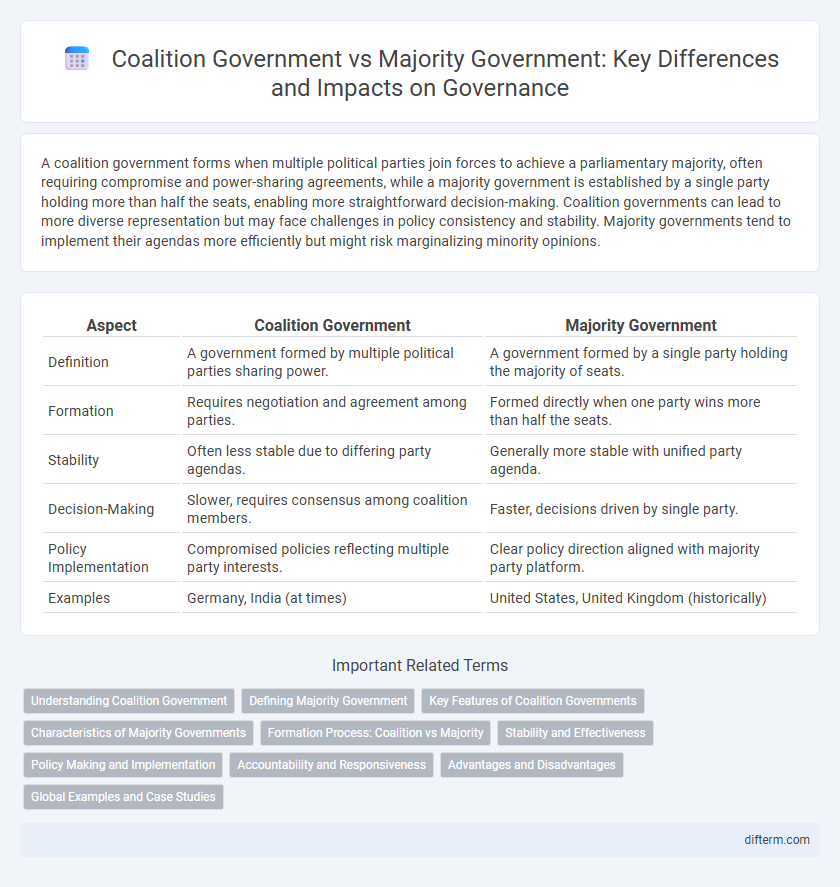A coalition government forms when multiple political parties join forces to achieve a parliamentary majority, often requiring compromise and power-sharing agreements, while a majority government is established by a single party holding more than half the seats, enabling more straightforward decision-making. Coalition governments can lead to more diverse representation but may face challenges in policy consistency and stability. Majority governments tend to implement their agendas more efficiently but might risk marginalizing minority opinions.
Table of Comparison
| Aspect | Coalition Government | Majority Government |
|---|---|---|
| Definition | A government formed by multiple political parties sharing power. | A government formed by a single party holding the majority of seats. |
| Formation | Requires negotiation and agreement among parties. | Formed directly when one party wins more than half the seats. |
| Stability | Often less stable due to differing party agendas. | Generally more stable with unified party agenda. |
| Decision-Making | Slower, requires consensus among coalition members. | Faster, decisions driven by single party. |
| Policy Implementation | Compromised policies reflecting multiple party interests. | Clear policy direction aligned with majority party platform. |
| Examples | Germany, India (at times) | United States, United Kingdom (historically) |
Understanding Coalition Government
A coalition government forms when multiple political parties collaborate to achieve a parliamentary majority, often requiring compromise on policies and shared leadership roles. Unlike a majority government, where a single party holds over 50% of seats and can implement its agenda independently, coalitions must negotiate to balance diverse party interests. Understanding coalition government highlights challenges such as maintaining unity, potential policy gridlocks, and the need for ongoing dialogue among partners to ensure stability.
Defining Majority Government
A majority government occurs when a single political party secures more than half of the seats in the legislature, allowing it to pass laws and implement policies without relying on support from other parties. This enables greater stability and decisiveness in governance compared to a coalition government, where multiple parties must collaborate to form a majority. Majority governments often result in clearer mandates and streamlined decision-making processes within parliamentary systems.
Key Features of Coalition Governments
Coalition governments are characterized by multiple political parties sharing power, often requiring negotiated agreements and compromise on policy decisions. These governments promote broader representation and inclusivity but may face challenges in maintaining stability due to differing party agendas. Key features include power-sharing arrangements, collective decision-making, and often a formal coalition agreement outlining governance priorities.
Characteristics of Majority Governments
Majority governments hold more than half of the legislative seats, enabling stable and decisive policymaking without reliance on other parties. They typically experience fewer internal conflicts and can implement their agenda efficiently, leading to greater political stability. This government type often enjoys stronger voter mandates, allowing for consistent governance and long-term strategic planning.
Formation Process: Coalition vs Majority
Coalition governments form through negotiations among multiple political parties to achieve a combined majority in the legislature, often involving compromises on policy and power-sharing agreements. Majority governments emerge when a single party secures more than half of the seats in the legislature, allowing for straightforward formation without negotiation or alliance requirements. The formation process of coalition governments is typically more complex and time-consuming compared to the immediate establishment of majority governments.
Stability and Effectiveness
Coalition governments often face challenges in maintaining stability due to the need for consensus among multiple parties, which can slow decision-making and reduce effectiveness. Majority governments tend to provide greater stability and more decisive governance as they have a clear mandate to implement policies without requiring agreement from other parties. This consolidated power often allows majority governments to enact legislation more efficiently and sustain long-term policy agendas.
Policy Making and Implementation
Coalition governments often require extensive negotiation among multiple parties, leading to more compromises in policy making that reflect diverse interests. Majority governments benefit from greater legislative control, enabling faster and more cohesive implementation of policies aligned with a single party's agenda. Policy stability tends to be higher in majority governments due to less dependence on inter-party agreements and coalition dynamics.
Accountability and Responsiveness
Coalition governments often enhance accountability by requiring member parties to negotiate and justify policy decisions to multiple stakeholders, ensuring diverse interests are represented. Majority governments typically offer greater responsiveness, enabling swift decision-making and implementation due to consolidated party control. The balance between accountability and responsiveness varies depending on the specific political context and institutional frameworks.
Advantages and Disadvantages
Coalition governments combine multiple political parties, promoting broader representation and policy compromise but often face instability and slower decision-making due to divergent interests. Majority governments enable decisive policy implementation and stability, benefiting from unified party control, but risk marginalizing minority views and reducing political diversity. The effectiveness of each system depends on the political landscape and the need for either collaborative governance or efficient execution.
Global Examples and Case Studies
Coalition governments often emerge in parliamentary systems where no single party secures an outright majority, as seen in Germany's CDU/CSU-SPD coalition, enabling policy compromise and broad representation. In contrast, majority governments, exemplified by the Conservative Party in the United Kingdom under Boris Johnson, typically enjoy greater legislative stability and the ability to pass bills without cross-party negotiation. Case studies from India demonstrate coalition complexity, particularly in the United Progressive Alliance (UPA) era, highlighting both policy paralysis risks and inclusive governance opportunities in diverse political landscapes.
coalition government vs majority government Infographic

 difterm.com
difterm.com